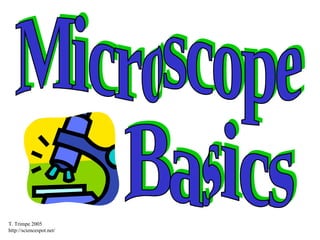
Microscope Basics Powerpoint
- 1. Microscope Basics T. Trimpe 2005 http://sciencespot.net/
- 2. Body Tube Nosepiece Objectives Stage Clips Light Ocular lens (Eyepiece) Arm Stage Coarse Adjustment Fine Adjustment Always carry a microscope with one hand holding the arm and one hand under the base . Base Diaphragm
- 3. What’s my power? To calculate the power of magnification, multiply the power of the ocular lens by the power of the objective . What are the powers of magnification for each of the objectives we have on our microscopes? Fill in the table on your worksheet.
- 4. Comparing Powers of Magnification We can see better details with higher the powers of magnification, but we cannot see as much of the image. Which of these images would be viewed at a higher power of magnification?
- 5. Let’s give it a try ... 1 – Turn on the microscope and then rotate the nosepiece to click the red-banded objective into place. 2 – Place a slide on the stage and secure it using the stage clips. Use the coarse adjustment knob (large knob) to get it the image into view and then use the fine adjustment knob (small knob) to make it clearer. 4 – When you are done, turn off the microscope and put up the slides you used. 3 – Once you have the image in view, rotate the nosepiece to view it under different powers. Draw what you see on your worksheet! Be careful with the largest objective! Sometimes there is not enough room and you will not be able to use it!
- 6. How to make a wet-mount slide … 1 – Get a clean slide and coverslip from your teacher. 2 – Place ONE drop of water in the middle of the slide. Don’t use too much or the water will run off the edge and make a mess! 3 – Place the edge of the cover slip on one side of the water drop. You do not need to use the stage clips when viewing wet-mount slides! 5 – Place the slide on the stage and view it first with the red-banded objective. Once you see the image, you can rotate the nosepiece to view the slide with the different objectives. 4 - Slowly lower the cover slip on top of the drop. Cover Slip Lower slowly